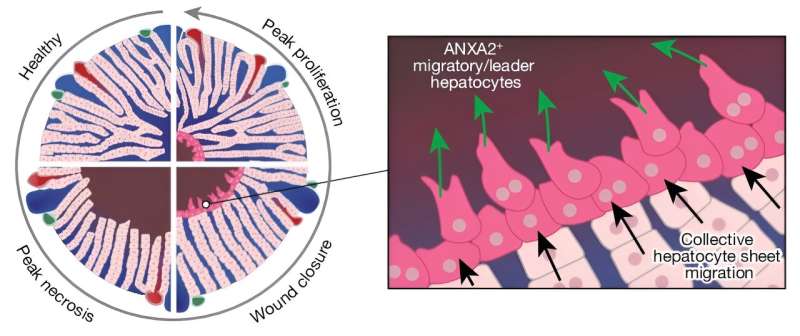This article has been reviewed according to Science X's editorial process and policies. Editors have highlighted the following attributes while ensuring the content's credibility:
fact-checked
peer-reviewed publication
trusted source
proofread
Study pinpoints cell that helps liver heal

A type of cell responsible for repairing damaged liver tissue has been uncovered for the first time by scientists.
The study, showing how these newfound cells migrate to the site of damage, provides fresh insights into the way the liver heals itself. The findings are published in the journal Nature.
Experts say the findings could spur the development of new therapies that harness the liver's unique capacity to regenerate following damage.
During acute liver failure, this ability to repair and regenerate is often overwhelmed, with patients requiring an emergency liver transplant to regain liver function.
Scientists from the University of Edinburgh studied human liver tissue from patients with acute liver failure for signs of cell proliferation and regeneration following the rapid loss of liver function.
They found that a significant proportion of cells retained the ability to multiply. There were, however, still substantial areas of damage in the patients' livers, suggesting that processes other than cell proliferation are critical during regeneration.
The research team profiled the genes within every liver cell in both healthy and regenerating human liver tissue to better understand the regeneration process. They did so using a cutting-edge technique called single cell RNA sequencing.
The findings uncovered a previously undetected population of wound-healing liver cells that emerge during human liver regeneration to boost its recovery.
Working with University of Glasgow scientists at the Cancer Research UK Scotland Institute, the team used special imaging techniques in mice to view the wound-healing cells in action.
During liver regeneration, so-called leader cells appear at the edge of the healthy tissue, dragging the tissue together to close the wound—similarly to how skin heals after a cut.
Imaging also revealed that the population of healing liver cells appears before cell proliferation begins.
Widespread infection is a major concern following acute liver failure. Bacteria from the gut can escape into the liver when the liver is damaged. This can lead to sepsis if the liver is unable to clear the infection.
The liver may prioritize the healing of wounds before cell proliferation to restore the gut-liver barrier and prevent the spread of bacteria, experts say.
"Cutting-edge technologies have allowed us to study human liver regeneration in high definition for the first time, facilitating the identification of a cell type that is critical for liver repair. We hope that our findings will accelerate the discovery of much-needed new treatments for patients with liver disease," says Professor Neil Henderson, Center for Inflammation Research, University of Edinburgh.
More information: K. P. Matchett et al, Multimodal decoding of human liver regeneration, Nature (2024). DOI: 10.1038/s41586-024-07376-2


















